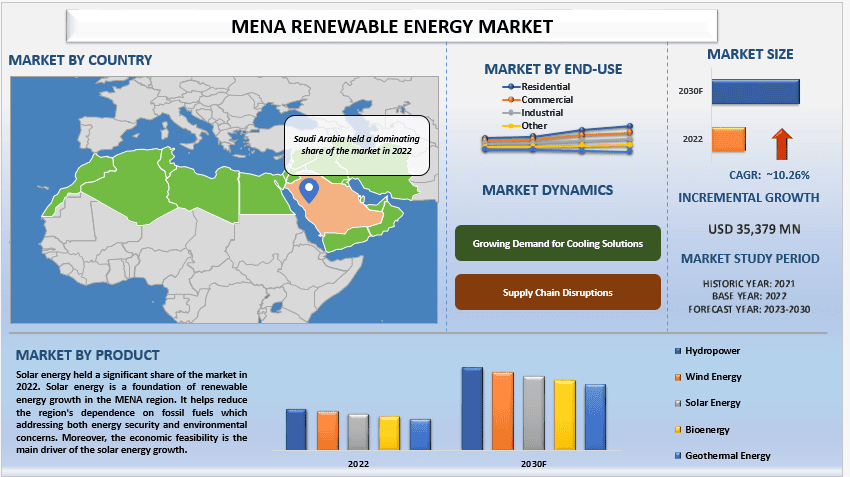
The MENA Renewable energy Market was valued at USD 35,379 Million in 2022 and is expected to grow at a strong CAGR of around 6.6% during the forecast period (2023-2030).
The Middle East and North Africa (MENA) region has long been synonymous with oil and gas production. However, recent years have witnessed a transformative shift towards renewable energy sources. As the world grapples with the realities of climate change and the need for sustainable energy, the MENA region is emerging as a crucial player in the global renewable energy landscape. In this article, we explore the top trends in renewable energy that are shaping the MENA region’s future.
Solar Power Dominance
MENA boasts one of the most abundant resources when it comes to renewable energy: sunlight. Solar power has taken center stage in the region’s clean energy transition. Nations like Saudi Arabia, the UAE, and Morocco have made significant investments in utility-scale solar projects. The vast deserts are ideal for solar farms, and advancements in photovoltaic technology have made harnessing this energy source more cost-effective. MENA is poised to become a global leader in solar energy generation.
While solar power dominates, wind energy is rapidly gaining traction. Coastal areas in the MENA region experience consistent and strong winds, making them ideal for wind power projects. Countries such as Egypt, Jordan, and Tunisia have invested in wind farms. Additionally, offshore wind projects are in the pipeline, indicating the growing interest in harnessing this renewable resource.
Energy Storage Revolution
As renewable energy sources are intermittent, energy storage is becoming a key trend. Battery technology advancements allow for the efficient storage of excess energy generated during the day for use at night or during periods of low renewable energy production. Energy storage solutions are crucial for maintaining grid stability and reliability as renewables make up a larger portion of the energy mix.
Access sample report (including graphs, charts, and figures): https://univdatos.com/reports/mena-renewable-energy-market?popup=report-enquiry
Green Hydrogen Production
The production of green hydrogen, a versatile fuel with zero emissions, is on the rise in the MENA region. Green hydrogen is produced through the electrolysis of water using electricity generated from renewable sources. The cost of generating electricity from wind and solar has fallen by 70%, and 80% respectively, and is forecast to continue falling by another 11% and 30% by 2030, over the last decade. Countries like Saudi Arabia and the UAE are investing heavily in green hydrogen projects, with plans to become major exporters of this clean fuel. This not only contributes to decarbonizing the energy sector but also opens new export opportunities.
Electrification of Transportation
The electrification of transportation is a global trend, and the MENA region is no exception. Countries in the region are promoting electric vehicles (EVs) and developing charging infrastructure. By transitioning to electric transportation, MENA countries can reduce greenhouse gas emissions and decrease their dependence on oil for domestic consumption. According to the World Population Review, in 2022, Saudi Arabia alone accounts for 17.5% of global oil reserves, with several other Middle Eastern countries also featuring in the top ten for global oil reserves.
Distributed Energy Systems and Microgrids
Distributed energy systems and microgrids are gaining popularity, particularly in remote areas and for industrial applications. These systems allow for the decentralized generation and distribution of energy, enhancing grid resilience and providing reliable power sources in areas with limited access to centralized grids.
International Collaborations and Investments
The MENA region has seen an influx of international collaborations and investments in the renewable energy sector. This not only brings in much-needed capital but also promotes knowledge exchange and technology transfer. It’s a mutually beneficial arrangement that accelerates the region’s clean energy transition.
Click here to view the Report Description & TOC: https://univdatos.com/reports/mena-renewable-energy-market
Policy Reforms and Regulatory Frameworks
Governments in the MENA region are enacting policies and regulatory frameworks to support renewable energy growth. Subsidies, incentives, and feed-in tariffs are being used to encourage private investment in the sector. Clear and stable regulatory environments are essential for attracting investors and developers.
In 2022, The Board of Directors of the Water and Electricity Regulatory Authority (WERA), Saudi Arabia chaired by Prince Abdulaziz bin Salman (Minister of Energy), authorized the regulatory framework to regulate renewable energy systems for self-consumption.
Climate Goals and Environmental Commitments
MENA nations are increasingly making commitments to reduce their carbon footprints and transition to cleaner energy sources. The urgency to address climate change and the need to improve air quality are driving these commitments. Renewable energy is a key tool in achieving these environmental goals.
Water-Energy Nexus
Water scarcity is a significant challenge in the MENA region. The nexus between water and energy is becoming more evident. Renewable energy solutions that are water-efficient, such as solar and wind power, are gaining favor. Moreover, innovative approaches are being explored to integrate desalination with renewable energy sources to address water needs sustainably.
While these trends paint an optimistic picture for the future of renewable energy in the MENA region, challenges remain. Grid integration, financing, and resource variability are among the hurdles that need to be addressed. Additionally, the political stability of the region plays a role in the realization of renewable energy projects.
Conclusion
In conclusion, the MENA region is undergoing a significant transformation in its energy landscape. The adoption of renewable energy sources is not only an environmental imperative but also an economic opportunity. With abundant solar and wind resources, advancements in technology, and a growing commitment to sustainability, the MENA region is poised to be a global leader in the renewable energy sector. As the world watches these trends unfold, the future of renewable energy in MENA looks brighter than ever. According to the UnivDatos the rising government’s carbon-reducing goals and massive abundance of renewable energy resources in Middle East and North Africa (MENA) region will drive the global scenario of the Renewable energy market.
Contact Us:
UnivDatos
Email: contact@univdatos.com
Contact no: +1 978 7330253
Website: www.univdatos.com
Linked In: https://www.linkedin.com/company/univ-datos/














